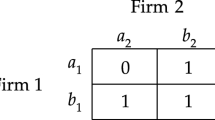Abstract
This paper attempts to formalize the differences between two methods of analysis used by judicial opinions in common law jurisdictions to contradict holdings posited by earlier opinions: “disagreeing” with the holdings of the earlier opinions and “attributing” holdings to the prior opinions. The paper will demonstrate that it is necessary to model both methods of analysis differently to generate an accurate picture of the state of legal authority in hypothetical examples, as well as in an example based on Barry Friedman’s analysis of the “stealth overruling” of Miranda v. Arizona through subsequent judicial interpretations. Because the question of whether “disagreement” and “attribution” need to be modeled separately relates to contradictions rather than to subtler interactions between holdings such as “distinguishing,” it can be answered using the simple technique of modeling holdings as propositional variables and evaluating the holdings using truth tables.




Similar content being viewed by others
Notes
In effect, because no truth value is deemed to contradict “Undecided,” lower courts in this model are not barred from deciding issues that have been left expressly undecided by higher courts.
As a mnemonic device, note that the abbreviations are ordered alphabetically from the strongest level of authority to the weakest.
That is to say, “(x → y) → ((z → ¬x) → (z → ¬y))” is not valid because it is falsifiable where x is false but y and z are true.
References
Alexander L (2012) Precedential constraint, its scope and strength: a brief survey of the possibilities and their merits. In: Bustamante T, Bernal C (eds) On the philosophy of precedent. Franz Steiner Verlag, Stuttgart, pp 75–82
Ashley KD, Rissland EL (1987) But, see, accord: generating blue book citations in hypo. In: Proceedings of the first international conference on artificial intelligence and law. ACM Press, New York, pp 67–74
Bench-Capon TJM, Coenen F (1992) Isomorphism and legal knowledge based systems. Artif Intell Law 1:65–86
Benesh SC, Reddick M (2002) Overruled: an event history analysis of lower court reaction to Supreme Court alteration of precedent. J Polit 64(2):534–550
Berman DH, Hafner CD (1991) Incorporating procedural context into a model of case-based legal reasoning. In: Proceedings of the third international conference on artificial intelligence and law. ACM Press, New York, pp 12–20
Berman DH, Hafner CD (1995) Understanding precedents in a temporal context of evolving legal doctrine. In: Proceedings of the fifth international conference on artificial intelligence and law. ACM Press, New York, pp 42–51
Bloom H (2003) A map of misreading: with a new preface. Oxford University Press, New York
Branting LK (1991) Reasoning with portions of precedents. In: Proceedings of the third international conference on artificial intelligence and law. ACM Press, New York, pp 145–154
Branting LK (1994) A computational model of ratio decidendi. Artif Intell Law 2:1–31
Carey M (2011) Modeling authority commitments in two search and seizure cases. In: Proceedings of the thirteenth international conference on artificial intelligence and law. ACM Press, New York, pp 181–188
Dworkin R (1986) Law’s empire. Belknap Press, Cambridge
Friedman B (2010) The wages of stealth overruling (with particular attention to Miranda v. Arizona). Georget Law J 99:1–63
Hage JC, Leenes R, Lodder AR (1994) Hard cases: a procedural approach. Artif Intell Law 2:113–167
Hart HLA (1958) Positivism and the separation of law and morals. Harv Law Rev 71:593–629
Horty JF (2011) Rules and reasons in the theory of precedent. Leg Theory 17:1–33
Horty JF, Bench-Capon TJM (2012) A factor-based definition of precedential constraint. Artif Intell Law 20:181–214
Kannan PM (1993) The precedential force of panel law. Marquette L Rev 76:755–766
Katz D (2006) Institutional rules, strategic behavior, and the legacy of Chief Justice William Rehnquist: setting the record straight on Dickerson v. United States. J Law Politics 22:303–340
Leach WB (1967) Revisionism in the House of Lords: the bastion of rigid stare decisis falls. Harv L Rev 80:797–803
Leval PN (2006) Judging under the constitution: dicta about dicta. N Y Univ Law Rev 81:1249–1282
McCarty LT (1995) An implementation of Eisner v. Macomber. In: Proceedings of the fifth international conference on artificial intelligence and law. ACM Press, New York, pp 276–286
McClurg SD, Comparato SA (2003) Rebellious or just misunderstood? Assessing measures of lower court compliance with Supreme Court precedent. Paper presented at the annual meeting of the American Political Science Association, Philadelphia
Raz J (2009) The authority of law: essays on law and morality: second edition. Oxford University Press, Oxford
Stinson JM (2010) Why dicta becomes holding and why it matters. Brooklyn Law Rev 76:219–264
Todd J (2007) Undead precedent: the curse of a holding limited to its facts. Tex Tech Law Rev 40:67–87
Twining W, Miers D (2010) How to do things with rules: fifth edition. Cambridge University Press, Cambridge
Waldron J (1994) Vagueness in law and language: some philosophical issues. Calif Law Rev 82:509–540
Wyner A, Bench-Capon TJM (2007) Argument schemes for legal case-based reasoning. In: Lodder AR, Mommers L (eds) Legal knowledge and information systems, JURIX 2007. IOS Press, Amsterdam, pp 139–149
Wyner A, Bench-Capon TJM (2009) Modelling judicial context in argumentation frameworks. J Log Comput 19:941–968
Acknowledgments
Thanks to Michael Poulshock and John Horty for their helpful comments and suggestions about this paper.
Author information
Authors and Affiliations
Corresponding author
Rights and permissions
About this article
Cite this article
Carey, M. Holdings about holdings: modeling contradictions in judicial precedent. Artif Intell Law 21, 341–365 (2013). https://doi.org/10.1007/s10506-013-9141-3
Published:
Issue Date:
DOI: https://doi.org/10.1007/s10506-013-9141-3




